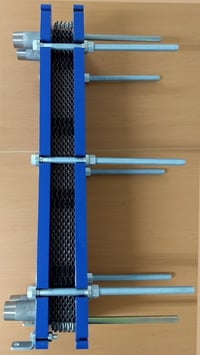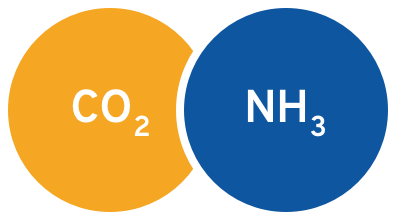Heat exchangers, all undisclosed must-know secrets.

The key piece of your refrigerating system
What is a Heat Exchanger? Features and functions
A Heat Exchanger is a technological device used in cooling systems that allows performing a thermal exchange between 2 fluids, which can come in contact or be separated by surfaces of different materials.
This equipment is used for several industrial refrigeration applications, from the food production industries to, pharmaceutical, metals, among plenty more. Furthermore, it can be used for comfort applications as air conditioning and water heating for the hotel industry.
What role does the Heat Exchanger play in a refrigerating system?
On a refrigeration system, the Plate Heat Exchanger works like a car radiator: the antifreeze absorbs the engine heat to re-cool and repeat the process.
Likewise, the heat exchanger is used in all applications requiring fluid heating or cooling, ranging from:
- Gasses
- Salt or sweet water
- Refrigerants
- Ammonia
- And much more, depending on its application.
Its role is key to streamline the process along the system and a proper engineering from its design, manufacturing and installation; it allows optimizing the process quality that enable the refrigeration cycle.
Recall that in the refrigeration cycle a Heat Exchanger can be used as a condenser, evaporator, economizer, oil cooler, liquid subcooler and water heater with gas discharge.
The Heat Exchanger can be installed, for instance, in a process prior to condensation as, upon cooling or water. It allows the condensator to use less energy, which reduces the expense on electricity.
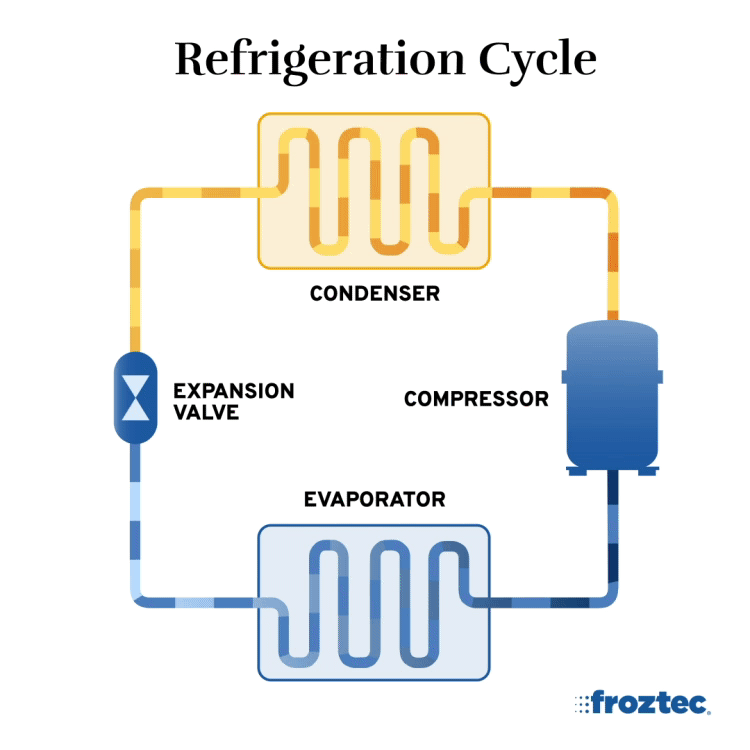
Do you wish to know more about how does the heat exchanger works?
👇🏽
We recommend you read the content in this link.
Types of Heat Exchangers. Main differences.
Heat Exchangers can be classified in 2 general types:
1. Direct contact: when the thermal exchange happens between two fluids that come into contact, even if they can be separated afterwards. A piece of equipment that makes this type of exchange is called a cooling tower.
2. Indirect contact: in this equipment, the interchange is made by means of the contact of the fluids with a surface that separate them one from another. Some examples are:
1. Shell and tube Heat Exchanger (shell and tube)
This type of equipment is used commonly in refineries and chemical laboratories; although in previous years it is being replaced by newer, smaller models, which are also of easier maintenance.
It is made from a series of tubes that are placed on a cylindrical shell which are held on each end by perforated ducts or channels.
2. Double tube Exchanger
This is the simplest Heat Exchanger used for basic processes.
It is made from two concentric tubes: a fluid circulates by the interior tube and on the other the space formed between two tubes. Therefore, the volume of the fluid to be cooled or heated is usually very low and industrial productions require plenty of these pieces of equipment, turning practically unsustainable.
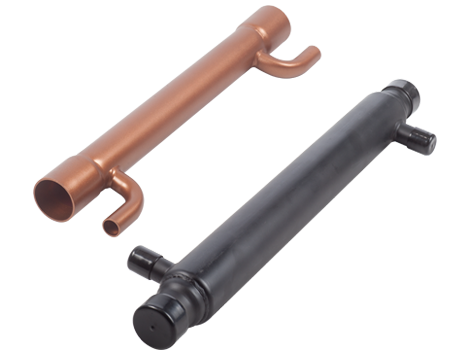
3. Plate Heat Exchangers
This type of equipment is being used more commonly in the industry thanks to the technology used (Alfa Laval), this enables several advantages like space and energy savings along with better efficiency in the heat exchanger.
The fluids circulate separately on them through steel or other material plates and perform the heat exchange through the plate surfaces.
There are several types of plate exchangers, in some scenarios; the plates can be welded, semi-welded or simply adjusted through gaskets.
Given its efficiency, it is used both in comfort applications as in processes requiring high levels of sanitary hygiene, as milk pasteurization, among others.

Why choosing a Plate Exchanger?
Strategic advantages of a Heat Exchanger: design, manufacturing and implementation.
- Lighter and easier to install.
- Use less space than some other shell and tube configurations.
- They are resistant to high pressure influxes.
- Offer much less vibration.
- Greater durability and resistance.
- Easier to provide maintenance.
- In some cases, the number of plates can be increased or reduced according to the needs of every project.
Design: it takes into account the dimensions, the number of necessary plates, the gaskets, the type of material used for the plates as well as its corrugation.
Manufacturing: manufacturing is a specialized process based on the type of fluid used for the heat exchange.
Implementation or application: a proper engineering process for a project must determine the application requisites. This should be considered considering variables such as fluid pressure drop, dimensions, temperatures and those physical or chemical characteristics of the fluids that require specific plate materials.
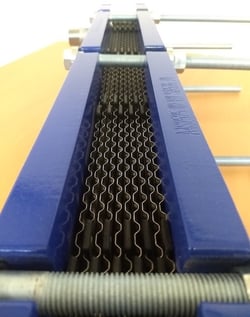
Difference between semi-welded, welded and corrugated plates
The plates in a Heat Exchanger must be aligned and the passing of the fluid must be made with the necessary flow and pressure to achieve the required temperatures.
The plates can be aligned by 3 different classes and each project will determine the type of alignment necessary:
Gasketed plates: the plates are aligned by pressure through gaskets; it is used for flows of lesser intensity compared with other type of alignments. This type of plates are commonly used for Heat Exchange between two fluids that do not change phase, for example water / water, water / oil, water / glycol.
Semi-welded plates: the semi-welded line can resist higher pressures compared with the use of gaskets.
Welded plates: Welded Plate Heat Exchangers provide efficient heat transference with a small fingerprint. They don’t need a lot of maintenance; they offer a prolonged lifespan and withstand high temperatures and extremely high pressures. They are used in a broad span of functions, including refrigeration, heating, evaporation and condensation.
Alfa Laval is the only manufacturer with a 100% stainless steel welded exchanger that can be used with fluids that would attack copper solder, such as ammonia.
The following materials are used for the elaboration of plates:
- Stainless steel AISI 304 and AISI 316: The stainless steel plates are the most common and are appropriate for almost all fluids. It is the most standardized material. However, it is important to take into account that this type of plates is sensitive to salt.
- Titanium: the titanium plates are used to attract salty liquids like brine or saltwater. This material increases the cost of the exchangers. Despite this, said material increases its sensitivity to acids.
- Hastelloy: Hastelloy plates are extremely acid resistant to acids and are used for chlorides, for instance, hydrochloric acid.
The plates of a Heat Exchanger have gaskets that are in charge of directing the fluids through the aligned plate pack, so as to allow the flow between them.
Materials used in gaskets generally are the following:
- Nitrile (NBR): it is used for heat exchanges for temperature below 100 °C.
- Ethylene Propylene Diene (EPDM): for temperatures up to 160 °C, but it is not oil compatible.
- Viton (FPM): a high cost, not standardized material used for organic solvents, lubricants or sulfuric acid, which is its most common application.
- Neoprene (CR): it is also a high price material, for high specialty equipment that handles gases like R22 or ammonia.
Types of fluids suitable for Heat Exchangers.
Depending on the design, manufacturing and implementation, the Plate Heat Exchangers can perform heat transference on the most common fluids used in industrial refrigeration processes.
- Water.
- Salt water.
- Acids.
- Gasses.
- Food liquids: milk, craft beer, etc.
- Natural refrigerating agents or glycolated solutions.
Natural refrigerants for your Heat Exchanger
The natural refrigerants exist without human intervention and due to its minimal impact on the environment they are the most commonly used along industries.
The heat exchanger technology progresses with the use of this type of refrigerants that aim to reduce polluting emissions in the atmosphere.
Natural refrigerants are:
- Ammonia (NH3, R717): used in industrial refrigeration, cold rooms, food processes and, increasingly, commercial refrigeration and chillers.
- Hydrocarbons (HC): apart from its use in industrial refrigeration, the HC refrigerants have been used in domestic fridges, commercial refrigeration, air conditioning and chillers.
- Carbon dioxide (CO2, R744): Its thermodynamic and transporting properties are excellent, making systems potentially efficient in cold climates. Due to its low toxicity and non-flammability, it has an A1 safety rating.

Alfa Laval, leading Heat Exchanger brand
Without a doubt, Alfa Laval is a world class referent in design and manufacturing of Plate Heat Exchanger, they are industry leaders and boost innovation year after year to streamline industrial refrigeration processes ever more complex.
There are 3 types of Plate Heat Exchangers developed and distributed by Alfa Laval all over the world. Each one has different models and dimensions, depending on its application in refrigeration projects.
Welded Plate Heat Exchangers
The Welded copper Plate Heat Exchangers provide efficient heat transfer with a small footprint. There is no need for major maintenance and offer a long lifespan as they can endure high temperatures and extremely high design pressures. They are used in a huge variety of functions, including refrigeration, heating, evaporation and condensation.
Alfa Laval also produces the only Heat Exchanger welded 100% stainless steel with patented AlfaNova technology
Heat Exchangers with plates and gasketed frames
Heat Exchangers with plate and frame with gasketing provide efficient heat transfer in compact equipment. The units have a flexible design and are easier to maintain.
The variety of products is extremely broad and is used in heating, refrigeration, heat recovery, evaporation and condensation. It is applied in industries ranging from HVAC, engine refrigeration, dairy products, and food, up to heavier processes as chemical process, oil production and energy generation.
Fused Plate Heat Exchangers
The Fused Plate Heat Exchangers are made from 100% stainless steel and provide efficient heat transfer; similarly, its environmental footprint is much reduced. They are major maintenance-free and offer a long lifespan.
They are appropriate for applications that require a high level of hygiene level and on those using aggressive mediums like ammonia or where copper and nickel pollution is not acceptable. They can withstand high temperatures or extremely high pressures.
Alfa Laval’s Innovative Heat Exchanger
In its recent history, Alfa Laval developed a Heat Exchanger made 100% from stainless steel called AlfaNova. This is a world’s first; its corrugated plates fuse using an innovative technology, known as Alfa-Fusion.
The results of this process are plates with a homogeneous microstructure in all exchangers; this provides strength, hygiene and high corrosion resistance.
AlfaNova is designed to handle demanding tasks in a broad series of applications and industrial utilities.
Currently, the company directs a great amount of its manufacturing area to this product and others that show that innovation is an important tool for refrigerating system efficiency all over the world.
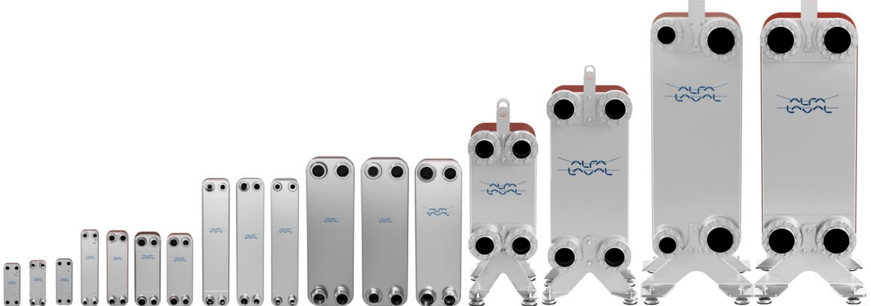
Alfa Laval, cost vs quality (comparison with other industry brands).
Alfa Laval has developed a second-to-none technology in effectiveness, guarantee and ease of mind it provides the teams of a fundamental process for energy savings.
Industrial refrigeration represents an important challenge in the need to spread the prevention culture, which consists in ensuring quality in equipment from its design, equipment manufacturing and installation.
![]() We recommend you: 5 challenges in installing industrial refrigeration systems.
We recommend you: 5 challenges in installing industrial refrigeration systems.
These 3 steps require the best equipment and specialized calculation, this way we avoid the client finding damages in its equipment, which prevents reductions in production or system wearing due to the use of more economic spare pieces.
Alfa Laval offers heat exchangers with huge advantages that long-term wise, allow for:
- Greater equipment lifespan
- Efficiency and lesser maintenance wearing.
- Energy savings.
- Avoid malfunctioning of one or several pieces of equipment of the refrigeration system.
- Technical support and specific catalogs for the use of each product.
Alfa Laval is a technological ally of Froztec that has allowed us to successfully face different challenges, ensuring these high tech pieces provide all its benefits to the current industrial refrigeration projects.

Applying a Plate Heat Exchanger in your industry
Do you really need a Plate Heat Exchanger?
As you know, this piece of equipment is a technological alternative to streamline industrial refrigeration industry. A Plate Heat Exchanger is particularly effective in systems that require fast thermal transfer, which helps optimizing and reducing the required energy for other components.
If you consider applying a Plate Heat Exchanger in your refrigeration system, reach out for our specialists, who will help you guarantee this piece to fulfill the purpose of streamlining your processes.
Factors to take into account before employing a Heat Exchanger in your project
You need to know in detail this piece of equipment if you wish to use it in the best way possible. Consider some of its advantages and contrast them with the requirements of the system in which you are working.
Important advantages of a Plate Heat Exchanger:
- Maintenance: A Plate Heat Exchanger allows easy plate access, thus any repairing or maintenance can be easily done. On the equipment with welded or fused plates, it is impossible to separate the plates; however, its advanced technology allows to provide greater efficiency and long durability in high pressure processes.
- Repairs: due to the state-of-the-art technology status, Plate Heat Exchangers account for minimal breakdown problems.
- Alfa Laval has an ample catalog and information on the capacity and compatibility of equipment along the necessary technical requirements for its optimal functioning.
- Spare parts: the companies that develop this technology (mainly, Alfa Laval, offer a high availability of spare parts or extra plates to expand the capacity of the Plate Heat Exchanger when required.
On Froztec International we have a partnership that allows us to train and offer specialized consultancy in the use of these Alfa Laval equipment.
Use case: Heat Exchangers applied in a craft beer production context.
Among the elaboration processes, there is one that requires a quick refrigeration process (prior to the fermentation) in which a plate exchanger intervenes.
Given its properties, the Plate Heat Exchanger of Alfa Laval allows to be used in production processes of food and beverages, as its materials allow reaching the required hygiene levels.
Use case: Heat Exchangers applied in the hospitality industry
There are 5 basic steps in the hotel industry necessary in the functioning of refrigerating systems.
- Energy savings and efficiency.
- Proper functioning of the equipment and avoid possible breakdowns.
- Reducing the environmental impact and access certifications to improve prestige.
- Host hygiene and healthcare.
- Comfort, excellence and basic services and care of water as pools and spas.
For these, the Plate Heat Exchanger has been showing efficiency and use of resources invested in the refrigerating systems. Among its possibilities within this hospitality industry, we can find:
- Efficiency in heating swimming pools: In the functioning and regulation of water temperatures, the Plate Exchangers have proven its effectiveness as it allows increasing the surface temperature in less time and with a high performance.
- Acclimatization system performance: The implementation of Heat Plate Exchangers in the acclimatization systems generate important savings in the electrical consumption, as it improves performance of other components and avoid wearing or high consumption.
- Double harnessing: water heating and cooling for room acclimatization: An effective method of applications of Plate Exchanger for energy savings consists in re-harnessing the absorbed heat by air conditioning for heating water in swimming pools.
Use case: Benefits of heat exchanger technology in the metallurgical industry
The metallurgical industry has refrigeration requirements in materials as molds and presses that need to release high heat levels. This implies the use of big amounts of energy through high capacity refrigeration systems.
The Plate Exchangers require to be manufactured with specific materials, as oftentimes the fluids have impurities or particles that demand a particular design and gaskets that withstand high temperatures.
Use case: Heat exchanger technology working in a quick-freeze process.
For instance, a proper functioning of the refrigerating cycle in the fish industry is paramount for the economic performance of the fish industry, from the fishing to its trading.
The Plate Exchanger can cool water at a fast speed for the quick freeze of sea produce and it is also used in ships for processes that require cold seawater or ice from seawater.
In industrial freezing plants where ammonia is used, we see Plate Heat Exchangers applied as economizers and as oil coolers, which help to increase the plant's energy efficiency and optimize its operation.

Quoting a Heat Exchanger for your refrigeration project
Although Plate Heat Exchangers are used in different industries, they are classified in two categories:
- Industrial: for varied industrial processes, in which invulnerable-to-pollution material is used.
- Sanitary: For processes that require maximum hygiene, as in the food industry.
Once the main application is determined, there are specific requirements that you must take into account to begin the quoting process for a proper exchanger that suits your every need.
Basic requirements to quote a Plate Heat Exchanger for your refrigeration project
- Its refrigeration purpose.
- The geographical zone of the project.
- The space needs.
Furthermore, several specifications are also considered to quote the design of a Plate Heat Exchanger, the most important of them being:
- The properties of the fluids we need to work to perform the thermal exchange.
- Allowed pressure falls: necessary data established by the rest of the refrigeration system. This data provides us with the number and types of plates needed in our equipment; the lesser the pressure, the more plates are necessary.
Alfa Laval has developed different types of plates that allow to reduce the pressure drop without using a greater number of plates. - Temperatures and flows of the heating/cooling medium: The entry and exit temperatures, heating and cooling we need to apply.
- Hygiene requirements: the area of installation and the size needs for its maintenance are taken into account.
Take into account that an inaccurate calculation compromises the equipment utility. Thus, it is important to have the consultancy of a refrigeration expert to analyze the technical requirements for a proper design.
An earnest and precise calculation of the specific needs is the key to consolidate a project that demands maximum efficiency.
Froztec backs your industrial refrigeration project
Specialized engineering is a technological support that several companies provide to industrial refrigeration contractors or to the end client to provide proper calculations and equipment for each project.
This assessment is particularly necessary in more sophisticated projects that require the special equipment design.
A company that provides this service must go with you along the way so that your projects meet the quality and efficiency expectations. Having this support can be a game changer in the quest for success for your refrigeration project.
In Froztec, this is and has been our objective during almost two decades: offering our clients industrial refrigeration equipment of excellent quality as well as engineering and specialized support services.
Updating is key; thus, we constantly offer courses and workshops about technologic innovations within the industry. Likewise, we provide assessment about the use of environmentally-respectful equipment.
If you are facing an important industrial refrigeration project, do consider receiving the best specialized backing, which will become your passport to greater business opportunities.
I want to quote a Heat Exchanger

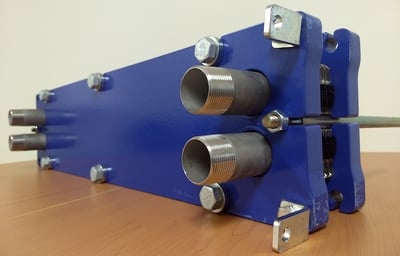

.jpg?width=4032&name=CB%20(19).jpg)
